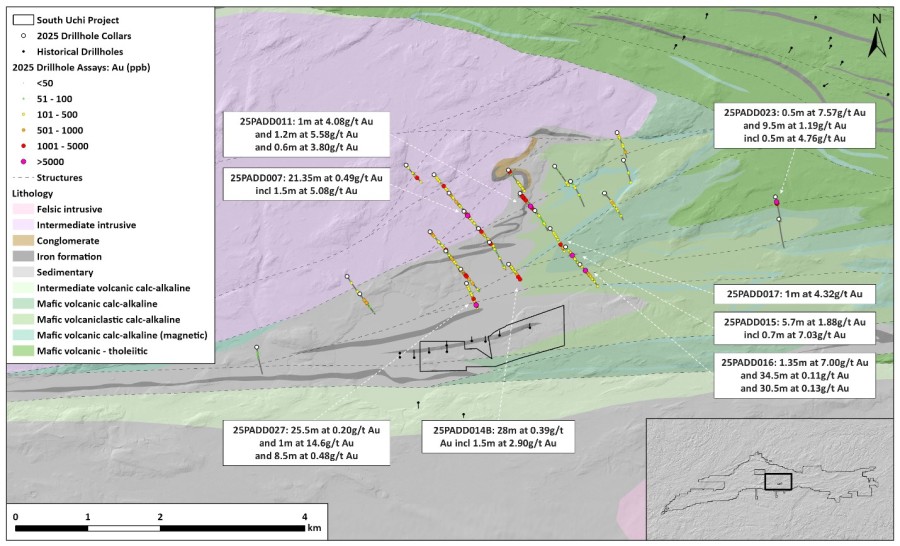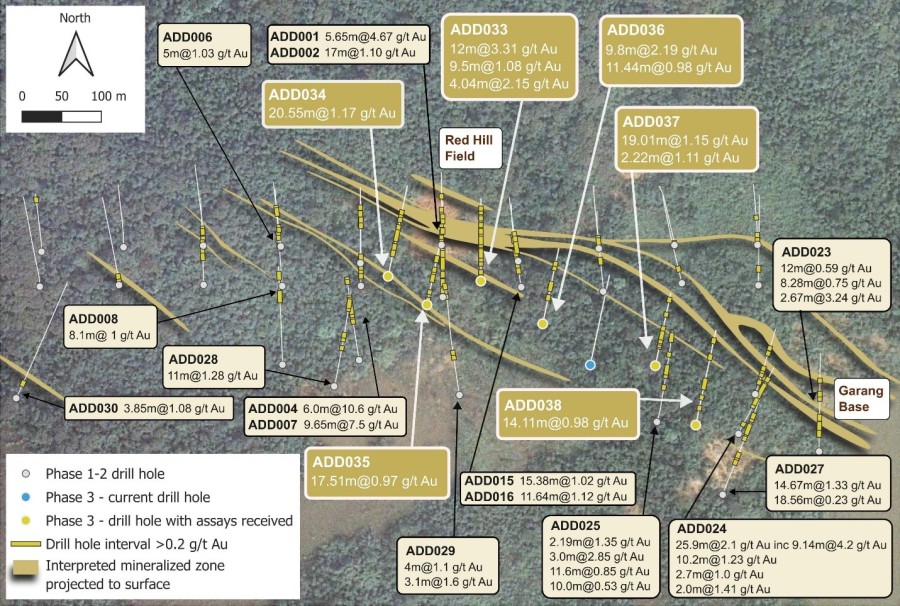New deep-imaging survey reveals vertically continuous mineral system extending to 1,200 metres-redefining exploration model at historic Montauban Mining Site
Vancouver, British Columbia--(Newsfile Corp. - July 11, 2025) - ESGold Corp. (CSE: ESAU) (OTCQB: ESAUF) (FSE: Z7D) ("ESGold" or the "Company"), a fully permitted near-term gold and silver producer, is pleased to announce the results of its recent Ambient Noise Tomography (ANT) survey1 operated by Caur Technologies at the Montauban Gold-Silver Project in Quebec. The preliminary interpretation of this advanced seismic imaging has revealed multiple deep-seated geological structures, suggesting that the Montauban system may extend far beyond its historically mined zones — opening the door to a potential district scale mineral system.
Originally scoped to map subsurface structures to 400 metres, the ANT survey exceeded expectations — imaging to depths of 1,200 metres and revealing a vertically extensive, laterally continuous geological system. These findings suggest that Montauban may represent a district-scale Volcanogenic Massive Sulphide (VMS) environment, rather than a singular deposit, with structural and lithological features consistent with some of the most prolific mining camps globally.
Key Highlights:
- Imaging Unveiled to Depths of 1,200 Meters: ANT survey has revealed deep-seated structural zones potentially hosting stacked mineralized lenses — a breakthrough for exploration at Montauban.
- New Interpretation Supports District-Scale Opportunity: Montauban may represent a clustered VMS system with structural repetition and geological similarities to world-class deposits like Sweden's Skellefte district.
- North-Central Feeder Zone Emerges: Strong contrast between high-velocity basement in the north and structurally complex southern domains presents multiple potential discovery targets; while the southern area shows more structural complexity — both priority areas for high-value targeting.
- Historic Assays + VTEM + ANT = Advanced Model Underway: The ongoing 3D geological model will integrate over 950 historic drill holes results, 2015 VTEM survey2 data, and this new deep seismic imaging to identify next-generation discovery zones.
André Gauthier, P.Geo., director of the company, added: "We now believe Montauban may be far more than a single deposit — it is emerging as a deep, district-scale system with possible structural and geological continuity," said André Gauthier, As a director of exploration. "These results may place Montauban into a new category of exploration potential. Where previous generations saw a series of shallow pods, we now see the signature of a vertically integrated mineral system — potentially with stacked, repeating lenses akin to those in VMS system or Broken Hill-style districts. We're seeing signatures that resemble the structural architecture of globally significant systems, but we are still in the early stage of exploration."
A New Lens on Montauban: From Legacy Mine to Blue-Sky Discovery
Montauban has long been known for its shallow, high-grade production of gold, silver, lead, and zinc, with over 2.6 million short tons historically mined. Yet until now, its deeper potential has remained locked beneath a century of fragmented data and under exploration.
The recently completed ANT survey — a non-invasive geophysical technique using ambient seismic noise — deployed 105 triaxial sensors across 10 km² of the property, continuously recording data for 49 days. The resulting high-resolution 3D shear-wave velocity model allows for unprecedented geological interpretation down to over +1,200 metres — revealing a vertically continuous and structurally complex system that strongly supports a multi-lens, camp-scale model.
The imaging revealed:
- Low-velocity zones near surface, corresponding to fractured, weathered, and previously mined areas.
- High-velocity basement rocks in the north-central region-suggesting compact, unfractured crystalline rock potentially hosting deeper feeder systems or stacked mineralized zones.
- Strong structural contrast between northern and southern zones-supporting the idea of multiple mineralized lenses rather than a single orebody.
The ANT Data: Depth, Structure, and Untapped Opportunity
The ANT results can be summarized by four key depth domains:
- 0-300 m: Low-velocity, fractured rock consistent with historical shallow mining zones and weathered overburden.
- 300-900 m: Transitional zone with heterogeneous velocity — potential host for additional unmined mineralized horizons.
- 900-1,200 m: A corridor of high-velocity rock, interpreted as crystalline basement or structurally competent feeder host — particularly in the north-central zone.
- >1,200 m: Vertically extensive, pipe-like domains in the northern half suggest possible feeder conduits or high-grade remobilization corridors, while complex folding and low-velocity contrasts in the southern half suggest repeated mineralized lenses.
The ANT survey reaffirms that Montauban's mineral system remains open at depth — both vertically and laterally — and that multiple zones across the property remain completely untested.
"Montauban is no longer just a development story — it's a discovery story in the making," said Gordon Robb, CEO of ESGold. "This survey has fundamentally changed the way we understand this special deposit. The continuity, depth, and scale of the structures we're seeing suggest that the original mine was just the tip of the iceberg. As we build toward production from the tailings, we're simultaneously unlocking the blue-sky potential beneath. This data confirms Montauban may be just the first chapter in a much larger district-scale opportunity, and we're excited to share that story with the world."
Why It Matters to Investors
- District-scale upside: This is no longer a single-zone reprocessing story. Montauban is evolving into a modern exploration asset with potential scale comparable to known VMS camps.
- Cash flow + discovery: Tailings reprocessing still forms the backbone of the near-term production plan-creating an ultra-rare dual-track story where cash flow and discovery are pursued simultaneously.
- Permits and construction in place: With permits secured and infrastructure installation underway, ESGold is positioned to capitalize on both operational and geological momentum.
- Repeatable, Scalable strategy: This platform model — combining cash-flowing from tailings redevelopment with modern exploration — is the blueprint for ESGold's long-term growth.
Appendix - Further Geological Interpretation and Comparative Context: Montauban in the Global VMS Landscape
Caur Technologies successfully completed an ambient noise tomography (ANT) survey for ESGold Corp over the Montauban mine site, located in Quebec's Capitale-Nationale region. The purpose of the survey was to image deep subsurface structures in support of gold exploration targeting volcanogenic massive sulfide (VMS) systems in a geologically complex area. The results provide valuable new insights into the geological framework of the site, offering a clearer understanding of the subsurface conditions that are critical for guiding exploration.
Despite extensive mining from 1910 to the 1970s targeting lead, zinc, silver, and gold, the Montauban region remains underexplored at depth. Most geological data come from tailings and a few shallow boreholes, with virtually no deep-penetrating geophysical data. This hampers understanding of the extent, geometry, and controls of mineralization. Ambient noise tomography (ANT) offers a non-invasive, cost-effective method to image deep crustal structures, highlighting velocity contrasts linked to lithological boundaries, alteration zones, and structural traps. ANT can guide drilling and support robust geological models by revealing features beyond the reach of historic exploration — unlocking untested targets and the region's deeper mineral potential.
The Montauban Group consists of quartzo-feldspathic gneiss, quartzite, marble, calcsilicates, and metavolcanic units like pillowed tholeiitic metabasalt and lapilli metatuff. These formed in a shallow-submarine setting during a late andesitic-to-felsic volcanic cycle — an environment favorable for volcanogenic massive sulfide (VMS) systems. The Montauban deposit is a gold-rich VMS system with stratiform to semi-massive lenses of Zn, Pb, Ag, and Au, typically linked to sericite-chlorite alteration and localized along shear zones, fold hinges, and lithological contacts.
The deposit's geometry reflects both syngenetic processes and structural reworking. Volcanic layers have been folded, faulted, and transposed, while metamorphism altered mineral textures and paragenesis, complicating ore zone delineation. Though shallow mineralized zones have been identified, their deeper continuity remains unclear. The setting aligns with other reworked VMS systems in high-grade metamorphic terranes, suggesting significant untapped potential. Historically, over 2.6 million short tons of Zn-Ag-Au were extracted from multiple zones, including Tetreault-Anacon and Montauban, demonstrating strong vertical and lateral continuity.
Major mineral deposits in high-grade metamorphic terrains are uncommon, but notable examples include Broken Hill and Nova Bollinger in Australia, and Sweden's Skellefte and Bergslagen deposits.
Montauban shares some features with Broken Hill-particularly Pb-Zn-Ag mineralization and rare felsic metavolcanic rocks. However, Broken Hill is generally considered a SEDEX deposit in metasedimentary rocks and lacks significant gold. Nova Bollinger, a Ni-Cu sulfide deposit hosted in ultramafic intrusions, also differs in both host rocks and mineralization style.
Closer analogues are Sweden's Rävliden and Garpenberg deposits — VMS systems formed in submarine volcanic settings and later metamorphosed during the 2.0-1.8 Ga Svecokarelian orogeny. These deposits and Montauban share key traits:
- Deposit Type: Originally syngenetic VMS deposits later overprinted by orogenic processes.
- Host Rocks & Metamorphism: Occur in felsic-dominated metavolcanic sequences altered to amphibolite-granulite facies.
- Mineralization: Polymetallic (Pb-Zn-Ag ± Au), lens-shaped, and structurally complex.
- Age: Rävliden is 2.0-1.8 Ga; Montauban is ~0.9 Ga.
- Structural Complexity: Montauban's folding, faulting, and lens repetition resemble Skellefte's 3D deformation patterns.
Unlike these better-known systems, Montauban has seen little modern exploration. Fragmented ownership, minimal deep drilling, and limited geophysical work have hampered discovery of concealed mineralization. Yet the geological parallels strongly suggest untapped potential at depth.
Qualified Person Statement
The technical content of this release has been reviewed and approved by André Gauthier, P.Geo., who is a Director of ESGold Corp. and a Qualified Person under National Instrument 43-101 - Standards of Disclosure for Mineral Projects ("NI 43-101").
____________________
References
1. The scientific and technical information included in this news release regarding the Ambient Noise Tomography (ANT) survey at the Montauban Project is based on the titled "Ambient Noise Tomography Survey - Montauban Area" (CAU-24-013), authored by Jean-Philippe Mercier, PhD, and reviewed by Nick Arndt, PhD, of Caur Technologies Inc., dated July 10, 2025.
2. The original VTEM survey was flown From December 6, 2014, to January 13, 2015, and was included in an NI 43-101 Report commissioned and filed by the Company in February 2022 (JPL Geoservices).
About ESGold Corp.
ESGold Corp. (CSE: ESAU) (OTCQB: ESAUF) (FSE: Z7D) is a fully permitted, pre-production gold and silver mining company at the forefront of scalable clean mining and exploration innovation. With proven expertise in Quebec, the Company is advancing its Montauban Gold-Silver Project toward near-term production while unlocking long-term value through strategic redevelopment, modern discovery tools, and sustainable resource recovery. Montauban, located 80 km west of Quebec City, represents a blueprint for cash-flow-generating legacy site redevelopment across North America.
For more information, please contact ESGold Corp. at +1-888-370-1059 or visit esgold.com for additional resources, including a French version of this press release, past news releases, a 3D model of the Montauban processing plant, media interviews, and opinion-editorial pieces.
Stay connected by following us on X (formerly Twitter), LinkedIn, and joining our Telegram channel.
For further information or to connect directly, please reach out to Gordon Robb, CEO of ESGold Corp. at This email address is being protected from spambots. You need JavaScript enabled to view it. or call 250-217-2321.
On behalf of the Board of Directors
ESGold Corp.
"Paul Mastantuono"
Chairman & COO
This email address is being protected from spambots. You need JavaScript enabled to view it.
+1-888-370-1059
Cautionary Note Regarding Forward-Looking Information
This news release contains "forward-looking information" within the meaning of applicable Canadian securities laws, including statements regarding future production, cash flow, exploration results, project economics, and permitting. Forward-looking information is based on reasonable assumptions that management believes are current but involve known and unknown risks and uncertainties that may cause actual results to differ materially. These risks are detailed in the Company's public filings on SEDAR+. Readers are cautioned not to place undue reliance on such statements. ESGold disclaims any obligation to update or revise any forward-looking information, except as required by law.
Neither the Canadian Securities Exchange nor its Regulation Services Provider accepts responsibility for the adequacy or accuracy of this release.





